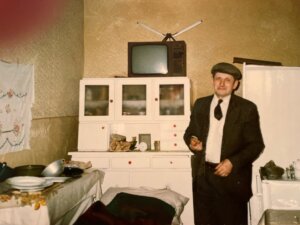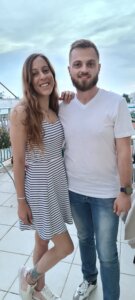In Auschwitz, a modern love story sparks a new Jewish chapter
“I am my own community,” says the first Jew to call Oswiecim home in two decades

Kamil Gut and Hila Weisz celebrate their wedding at the Oswiecim town hall. Courtesy of Kamil Gut and Hila Weisz
The author began reporting this story on a trip to Poland sponsored by FASPE, Fellowships at Auschwitz for the Study of Professional Ethics.
OSWIECIM, Poland — This sunny town of roadside strawberry stands and flower-filled roundabouts lies less than a mile from the darkness of Auschwitz, with its barbed wire, starvation cells and gas chambers.
Before the Holocaust, Oswiecim was home to 8,000 Jews and at least a dozen synagogues. Its last Jewish resident, Shimson Kluger, died in 2000. There might never have been another had Hila Weisz not started to fall in love on a bus in Warsaw.
Like many Israelis, Weisz had been hearing about the horrors of the Holocaust since she was 4 years old. Her paternal grandmother had survived Birkenau, the death camp adjacent to Auschwitz, but three siblings and their father were all murdered in the camps.
When Weisz told her grandmother she’d be visiting Poland for a study tour in 2007, her grandmother discouraged her. “She was trying to protect me from her past,” Weisz explained, years later. Weisz went anyway, and returned again in 2021 for a teaching certification course focused on World War II history.
It was on her second study tour to Auschwitz that she met Kamil Gut, a Polish barista and musician with a disarming smile. They sat together on the bus from Warsaw.
Gut was born in Oswiecim. Auschwitz lay on the outskirts of town, and no one really talked about it at home. So when people ask what it was like to grow up next to the concentration camp, Gut replies: “It was normal.”
He recalls first learning about the Holocaust when he was around 13. “There are two types of people,” Gut told me over the phone. “One type is like, ‘OK, it happened, let’s carry on with our lives.’ The other type says, ‘Let’s learn more about that.’”
Gut, 29, is the second type. While pursuing his bachelor’s degree, he did an internship at the Auschwitz museum. Once, while helping a visitor in a wheelchair, he heard the head of Oswieicim’s sole remaining synagogue narrating the town’s centuries of rich Jewish history. “It was like a switch in my mind,” Gut said. He realized that he could study not only death in Oswiecim, but also life.
In 2019, he started working at Café Bergson, a bright space selling lattes and bagels inside Oswiecim’s Jewish Museum. Through the museum’s exhibits and archives, he started exploring the town’s Jewish history, and uncovered a striking theme: Over numerous periods of persecution and discrimination, Oswiecim stood out among Polish towns for welcoming and sheltering Jews.
He found this in the mid 1500s, when Jews fleeing waves of antisemitism across Europe first came to Oswiecim. He found it in the late 1800s, when the town’s 8,000 Jewish residents included lawyers, council members and even the deputy mayor, earning it the pet name “Polish Jerusalem.” And he found it in the 1930s, when the Nazis started imprisoning and killing Jews in Auschwitz, and some residents of Oswiecim risked their lives to sneak in food and help prisoners escape.
Then there was Kluger, who returned to his childhood home in Oswiecim after surviving the Holocaust and working as an engineer in Sweden. Although kids sometimes pointed and called him names, several residents brought Kluger food and other necessities, as his intense post-traumatic stress stopped him from leaving his house often. It is that very house that, in 2014, was renovated into Café Bergson, where Gut spent his days brewing coffee and chatting with visitors to the Jewish museum.

So when Gut and Weisz found themselves seated together on that tour bus, they started talking – and never stopped. As the bus passed the Polish countryside’s grassy knolls and grazing cows, Gut and Weisz ping-ponged questions about World War II history and Jewish theology. “He had a lot of questions that I had the answers to,” recalled Weisz, now 33, “and I had a lot of questions that he had the answers to.”
The two were inseparable during the seven-day study tour, listening to music together and sitting side by side as they traveled through Poland. He felt an immediate connection to her intelligence and sense of humor, and she found him charmingly talkative. When they visited Oswiecim, Weisz found an old prisoner exchange list that included the name Josef Weisz, which she believed was her paternal grandfather, who survived the war and died in 1971.
She knew then that she would one day come back to Oswiecim – and to Gut.
It only took three months. The couple talked on the phone nonstop and visited each other often. When Weisz came to Poland in December, 2022, they celebrated “Christmakkah,” with Gut lighting candles on a menorah and Weisz hanging ornaments on the sparkling Christmas tree.

In the winter of 2023, Gut booked her a surprise trip to Amsterdam, Weisz’s favorite city. When they couldn’t find her favorite bridge, Gut almost had a breakdown. “He was acting so strange,” Weisz told me.
The reason became clear when they walked onto the bridge on a frosty January evening, and Gut got down on one knee. A passerby in a hijab congratulated them and offered to make a video. “It was pretty symbolic,” Gut said of members of the three Abrahamic religions being together in this defining moment of their lives.
They married in April at Oswiecim town hall and had the reception in Café Bergson — Kluger’s former living room. “It’s a tough place to live with this burden of the history,” Gut acknowledged, “but at the same time, it’s my hometown. This is where I belong.”
But the idea of living so close to Auschwitz made Weisz a bit queasy. “Before I moved I had this thought – am I really going to do that?” she remembered wondering. “I mean, it’s Auschwitz. Why?”
The couple started their married life in a quiet apartment with a balcony near the Jewish cemetery. In this setting, Weisz’s Holocaust research for her master’s degree took on new meaning. A year later, she said: “I feel like it’s something I need to do.”
Weisz, taking over Kluger’s role as the only Jew in Oswiecim, said she feels warmly welcomed. Her landlady checks in whenever there is news of violence in Israel. Visitors are usually excited to ask her questions about Judaism.
But Weisz, who grew up in a coastal city in Israel’s north, misses having other Jews around – the Jewish holidays, the Shabbat dinners, the prayers said in unison. She often goes alone to the synagogue, seeking forgiveness from the Torah for not having enough people in town to form a minyan, the quorum required for reading it. She asks Jewish visitors to Auschwitz to say the Mourner’s Kaddish for her late father. “I am my own community,” she told me.
It makes her feel a deep empathy for Kluger, who lived all alone in his last years. When he died in 2000, there were no other Jews around to bury him or say kaddish. The Jewish Center called the Auschwitz museum to see if there were any visitors around who could help. A group from an Orthodox school in New York had recently departed the museum for Krakow, but they circled back to lead the funeral. The visiting rabbi solemnly performed the Jewish ritual for bodily purification, or “taharah,” and laid Kluger to rest in the cemetery near the apartment where Weisz and Gut would move more than two decades later.
The couple wants to show the world that Oswiecim is more than just the town next to Auschwitz. They note that its Yiddish name, Oshpitzin, means inviting people into your home, and love to tell guests stories of interfaith friendships in the town’s history and about the variety of Jewish residents who have called it home. “There’s no point of focusing on the death without understanding who they killed,” Weisz said, referring to Auschwitz. “There is more life than death.”















